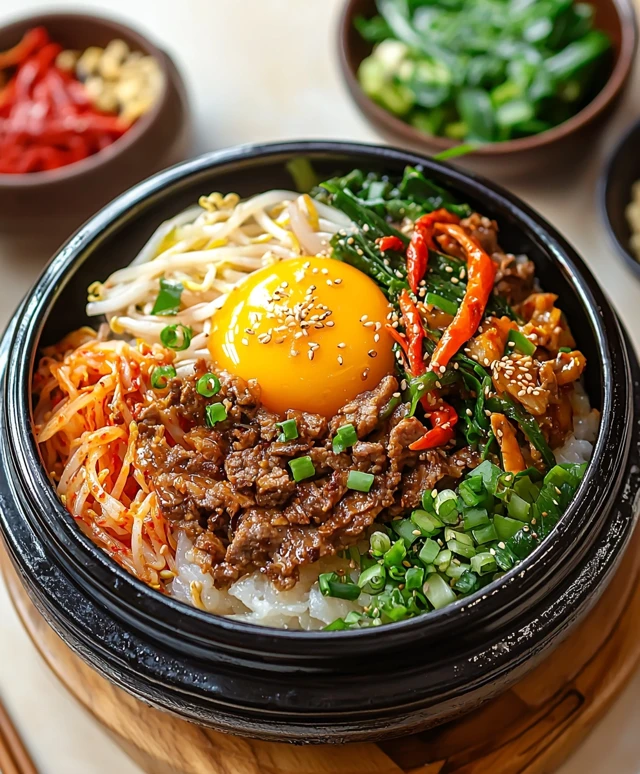Bibimbap dish is a vibrant and flavorful Korean meal that has captured the hearts of food lovers around the world. This delightful combination of rice, vegetables, and protein, all topped with a perfectly fried egg and a dollop of spicy gochujang, creates a symphony of tastes and textures that is simply irresistible. The origins of bibimbap can be traced back to the late 19th century, where it was traditionally served as a way to use up leftover ingredients, making it not only a delicious choice but also a practical one.
People adore bibimbap dish for its versatility and convenience; you can customize it with your favorite vegetables and proteins, making it suitable for any dietary preference. The balance of flavorsfrom the earthy vegetables to the rich egg and spicy sauceensures that every bite is a delightful experience. Whether you’re enjoying it at a bustling Korean restaurant or preparing it at home, bibimbap dish is sure to bring a smile to your face and warmth to your heart.
Ingredients:
- 2 cups of cooked white rice (short-grain preferred)
- 1 cup of spinach, blanched and chopped
- 1 cup of bean sprouts, blanched
- 1 cup of carrots, julienned
- 1 cup of zucchini, julienned
- 1 cup of shiitake mushrooms, sliced
- 2 eggs
- 1 tablespoon of sesame oil
- 2 tablespoons of vegetable oil
- 2 tablespoons of gochujang (Korean chili paste)
- 1 tablespoon of soy sauce
- 1 tablespoon of sesame seeds
- 1 clove of garlic, minced
- Salt, to taste
- Optional: sliced beef or tofu for protein
Preparing the Vegetables
Lets start by prepping our vegetables. This is a crucial step because the freshness and texture of the veggies will make our bibimbap shine!
- Spinach: In a pot of boiling water, blanch the spinach for about 30 seconds. Drain and rinse under cold water to stop the cooking process. Squeeze out excess water and chop it finely. In a bowl, mix the spinach with a pinch of salt and a drizzle of sesame oil. Set aside.
- Bean Sprouts: Blanch the bean sprouts in boiling water for about 2 minutes. Drain and rinse under cold water. You can season them with a little salt and sesame oil if you like, but they can also be left plain. Set aside.
- Carrots: Julienne the carrots into thin strips. Heat 1 tablespoon of vegetable oil in a pan over medium heat. Add the carrots and sauté for about 2-3 minutes until they are tender but still crisp. Season with a pinch of salt. Remove from the pan and set aside.
- Zucchini: Julienne the zucchini in the same way as the carrots. Sauté in the same pan with a little more oil if needed, for about 2-3 minutes. Season with salt and set aside.
- Mushrooms: Slice the shiitake mushrooms. In the same pan, add a bit more oil if necessary and sauté the mushrooms for about 4-5 minutes until they are tender. Add minced garlic and sauté for an additional minute. Season with a little soy sauce and set aside.
Preparing the Protein (Optional)
If youre adding protein like beef or tofu, heres how to prepare it:
- Beef: Thinly slice the beef and marinate it in a mixture of soy sauce, sesame oil, and a pinch of sugar for about 15 minutes. In the same pan, cook the beef over medium-high heat until browned and cooked through, about 5-7 minutes. Remove and set aside.
- Tofu: If you prefer tofu, cut it into cubes and pan-fry in a little vegetable oil until golden brown on all sides. Season with a bit of soy sauce and set aside.
Cooking the Eggs
Now, lets cook the eggs. Traditionally, bibimbap is topped with a fried egg, but you can also use a poached egg if you prefer.
- In a non-stick skillet, heat a little vegetable oil over medium heat.
- Crack the eggs into the skillet and cook until the whites are set but the yolks are still runny, about 2-3 minutes. If you like your yolks firmer, cook for an additional minute.
Assembling the Bibimbap
Now comes the fun partassembling our bibimbap! This is where you can get creative and make it visually appealing.
- In a large bowl, place a generous serving of cooked rice at the bottom. This will be the base of your bibimbap.
- Arrange the prepared vegetables on top of the rice in sections. You can create a beautiful rainbow effect by placing each vegetable in

Conclusion:
In summary, this bibimbap recipe is a must-try for anyone looking to explore the vibrant flavors and textures of Korean cuisine. The combination of perfectly cooked rice, an array of colorful vegetables, and a savory sauce creates a dish that is not only visually appealing but also incredibly satisfying. Whether you choose to stick to the traditional ingredients or mix it up with your favorite proteins like chicken, beef, or tofu, the possibilities are endless. For a fun twist, consider adding a fried egg on top for that extra richness, or try incorporating seasonal vegetables to keep things fresh and exciting. You can also experiment with different sauces, such as a spicy gochujang or a tangy sesame dressing, to customize the flavor profile to your liking. I encourage you to give this bibimbap recipe a try and share your experience with friends and family. Its a fantastic way to introduce them to the joys of Korean cooking, and Id love to hear how your version turns out! Dont forget to snap a photo and tag me on social media; I cant wait to see your delicious creations. Happy cooking! PrintBibimbap Dish: A Flavorful Journey into Korean Cuisine
- Total Time: 45 minutes
- Yield: 4 servings
Description
This vibrant and nutritious Bibimbap is a traditional Korean dish featuring a colorful array of sautéed vegetables, protein, and a perfectly cooked egg, all served over a bed of fluffy rice and topped with spicy gochujang. It’s a delightful mix of flavors and textures that can be customized to your liking!
Ingredients
- cooked protein (beef or tofu)
- fried or poached egg
- gochujang
- soy sauce
- sesame oil
- sesame seeds
Instructions
- If using, add the cooked protein (beef or tofu) on top of the vegetables.
- Top with the fried or poached egg in the center.
- Drizzle with gochujang, soy sauce, and sesame oil to taste.
- Sprinkle with sesame seeds for garnish.
- To serve, mix everything together before eating to combine the flavors.
Notes
- Feel free to customize your bibimbap with any vegetables you have on hand.
- You can also adjust the level of spiciness by adding more or less gochujang.
- This dish is versatile and can be made vegetarian or vegan by omitting the egg and using tofu as the protein source.
- Prep Time: 30 minutes
- Cook Time: 15 minutes





Leave a Comment